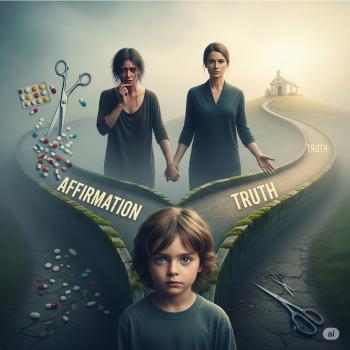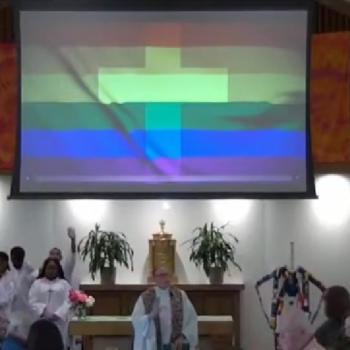How can the Church change its views on same-sex marriage?
An old idiom states, “a zebra can’t change its stripes.” According to idioms.thefreedictionary.com, this means “one will stay true to one’s nature, even if one pretends or claims otherwise.” This idiom came to mind after reading an article on the National Catholic Report titled, New Ways’ Sr. Jeannine Gramick sees a future for same-sex marriage in Catholic Church. In the article, Sr. Jeannine Gramick states that she believes the Catholic Church “will one day offer sacramental marriage to same-sex couples.” She goes on to state that current sacramental theologians “are looking at the issue of marriage for same-sex couples.”
Given what I understand about doctrinal development within the Catholic Church, my mind immediately went to the question of “how.” How can the Catholic Church change its views on marriage to include same sex couples? I first lay out the criteria for authentic doctrinal development. I then conclude with the only possible hope I see for the “change” those like Sr. Jeannine Gramick seek—The Synodal Path. Does The Synodal Path meet the requirements for authentic doctrinal development, or does it fall into the category of theological corruption?
Doctrinal Development in the Catholic Church
First off, in Catholicism, doctrines cannot change; they can only develop. This understanding of doctrine was most clearly articulated by Cardinal John Henry Newman (1801 to 1890). Sr. Gramick correctly quotes Cardinal Newman when he said, “to live is to change and to be perfect is to have changed often.” But she fails to quote Newman in full. The full quote is:
In a higher world it is otherwise, but here below to live is to change, and to be perfect is to have changed often. [emphasis added]
By the “higher world,” Newman here means the eternal world where no change exists. We on earth change towards perfection as we align ourselves towards the higher world that changes not. Furthermore, Newman clearly does not mean by this saying that change in doctrine often leads to perfection. On the contrary, Newman clearly lays out the needed criteria in his seminal work An Essay on the Development of Christian Doctrine. In this work, Newman differentiates between doctrinal changes he sees as corruptions and authentic doctrinal developments.
Corruption Vs. Development
Moreover, to Newman, a corruption deviates from what came before theologically, while an authentic doctrinal development naturally grows out of what came before it. He states:
A doctrine, then, professed in its mature years by a philosophy or religion, is likely to be a true development, not a corruption, in proportion as it seems to be the logical issue of its original teaching. (Section 4) [emphasis added]
As a tree develops from an acorn, so, too, a doctrine develops from what came before it. It cannot deviate from what came before or it will become a corruption. Therefore, an authentic doctrinal development must logically flow from an original teaching.
Newman’s Tests for Authenticity
Newman offers seven tests to determine the authenticity of doctrine to ensure it is not a corruption. The below links directly to each chapter of his work.
Test 1: Preservation of Type
I have said above, that, whereas all great ideas are found, as time goes on, to involve much which was not seen at first to belong to them, and have developments, that is enlargements, applications, uses and fortunes, very various, one security against error and perversion in the process is the maintenance of the original type, which the idea presented to the world at its origin, amid and through all its apparent changes and vicissitudes from first to last. (Chapter 6) [emphasis added]
Again, an acorn cannot develop into an aardvark. So, too, an authentic doctrinal development does not develop into a corruption. It maintains the original type.
Test 2: Continuity of Principles
Principles are abstract and general, doctrines relate to facts; doctrines develop, and principles at first sight do not; doctrines grow and are enlarged, principles are permanent; doctrines are intellectual, and principles are more immediately ethical and practical. (Section 2)
And
Thus the continuity or the alteration of the principles on which an idea has developed is a second mark of discrimination between a true development and a corruption. (Section 2)
Here, Newman states that, as a doctrine develops, it cannot contradict its underlying principle. For example, the Church may develop its view on social justice, but this may not contradict the principle of the sanctity of life from conception to natural death.
Test 3: Power of Assimilation
A new element of order and composition has come among them; and its life is proved by this capacity of expansion, without disarrangement or dissolution. An eclectic, conservative, assimilating, healing, moulding process, a unitive power, is of the essence, and a third test, of a faithful development. (Section 3)
To clarify, Newman states that the Church can assimilate only healthy things from culture but must discard those things that are not. An authentic doctrinal development strengthens and maintains the overall health of the Church. A corruption weakens and sickens it.
Test 4: Logical Sequence
A doctrine, then, professed in its mature years by a philosophy or religion, is likely to be a true development, not a corruption, in proportion as it seems to be the logical issue of its original teaching. (Section 4)
Furthermore, an authentic doctrinal development logically follows from past doctrines. For example, the development of the Sacrament of Reconciliation developed out of a need for forgiveness of sin after baptism. As the Church dealt with the sin of its member throughout her history, the mode changed, but only changed logically. For more detail on this development, please click here for my previous article on the subject.
Test 5: Anticipation of Its Future
The fact, then, of such early or recurring intimations of tendencies which afterwards are fully realized, is a sort of evidence that those later and more systematic fulfilments are only in accordance with the original idea. (Section 5) [emphasis added]
Therefore, to Newman, an earlier idea undeveloped in the past may come to fulfillment later through a more thorough and systematic method of study, if it is in accordance with the original idea. If it contradicts the original, a corruption took place.
Test 6: Conservative Action Upon Its Past
As developments which are preceded by definite indications have a fair presumption in their favour, so those which do but contradict and reverse the course of doctrine which has been developed before them, and out of which they spring, are certainly corrupt; for a corruption is a development in that very stage in which it ceases to illustrate, and begins to disturb, the acquisitions gained in its previous history. (Section 6)
Moreover, as a conservative, this test resonates with me. Conservatives seek to conserve and retain what came before. Theologically speaking, an authentic doctrinal development conserves and retains what came before. A corruption does the opposite by changing it.
Test 7: Chronic Vigor
Corruption cannot, therefore, be of long standing; and thus duration is another test of a faithful development. (Section 7)
Newman concludes with vigor, as in endurance. An authentic doctrinal development endures, while a corruption eventually dies out.
Summa Newman
To summarize Newman, an authentic doctrinal development must meet the below criteria.
- Maintains the original type.
- Cannot contradict its underlying principle.
- Maintains the overall health of the Church.
- Logically follows from past doctrines.
- Remains in accordance with the original idea when fully developed.
- Conserves and retains what came before.
- Stands the test of time.
Those who seek to “change” Church doctrine must meet all seven of the criteria listed above. The only alternative option involves turning aside from authentic doctrinal development and embraces corruption. One possible ray of hope for those in the vein of Sr. Jeannine Gramick is known as the The Synodal Path. I now turn to this concept in my conclusion.
To Conclude
In conclusion, I want to take a quick look at The Synodal Path and see if it meets the requirements for authentic doctrinal development. This movement’s current epicenter resides in Germany. The leaders of The Synodal Path seek to change the Church in four keyways: (summarized by Catholic News Agency)
- “Power and Separation of Powers in the Church – Joint Participation and Involvement in the Mission”
- “Life in succeeding relationships – Living Love in Sexuality and Partnership”
- “Priestly Existence Today”
- “Women in Ministries and Offices in the Church
The first seeks to open doctrinal approval to all members of the faithful, especially the ordination of bishops. The next concerns a reevaluation homosexual relationship with the Catholic Church and not classify homosexual acts as sinful. Thirdly, The Synodal Path calls for married priest within the Church (Latin Rite). Lastly, the Path seeks reform to allow for women’s ordination to the priesthood. I challenge all who support such “changes” to evaluate the “Reasoning” section of each document and tell me if they meet the criteria set up by Cardinal Newman. In my assessment, The Synodal Path is yet another attempt at theological corruption and I think Cardinal Newman agrees with me.
What do you think?
Like what you read? Please check out my other writing here. Furthermore, please read. Moreover, thanks!
Please like and follow me on Facebook and Twitter.












